
HOME < Technology < What is 5G ?
1. Introduction
5G is the fifth generation of mobile connectivity, following on from 4G. It succeeds the 4G (LTE, LTE-A), 3G (UMTS, WCDMA) and 2G (GSM) systems. The first phase of 5G specifications in Release-15 will be completed by April 2019 to accommodate the early commercial deployment. The second phase in Release-16 is due to be completed by April 2020 for submission to the ITU as a candidate for IMT-2020 technology.

5G performance targets high data rate, reduced latency, energy saving, cost reduction, higher system capacity, and massive device connectivity. The main difference from 4G as below.
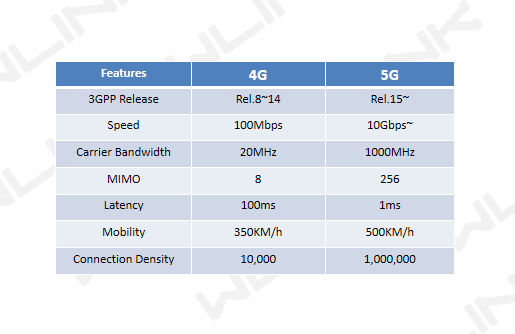
2. 5G features
2.1 Speed
LTE advanced technology is capable of data rate up to 1 GBPS on 4G networks. 5G technology will support data rate up to 5 to 10 GBPS on mobile devices and above 20 GBPS.
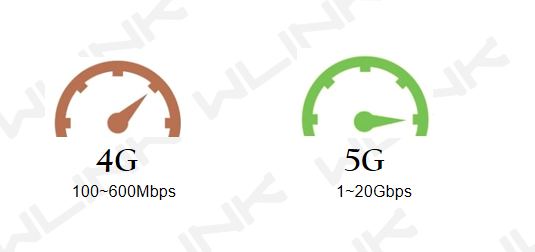
2.2 Latency
Latency of 4G network is in the range of 200 to 100 milliseconds. During 5G testing, engineers were able to achieve and demonstrate a lower latency of 1 to 3 milliseconds. Low latency is very significant in many mission critical applications and thus 5G technology is suitable for low latency applications.
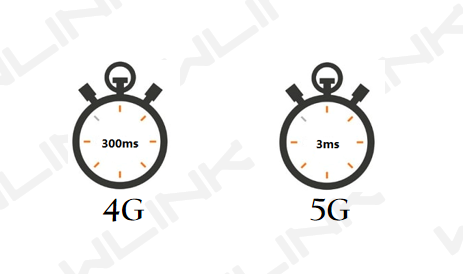
2.3 Frequency Spectrum
The air interface defined by 3GPP for 5G is known as New Radio (NR), and the specification is subdivided into two frequency bands, FR1 (below 6 GHz) and FR2 (mmWave), each with different capabilities.

FR1 (< 6 GHz)
Due to the scarcity of continuous spectrum in this crowded frequency range. The band that is most likely to be universally used for 5G in this range is around 3.5 GHz.The maximum channel bandwidth defined for FR1 is 100 MHz.
FR2 (> 24 GHz)
The minimum channel bandwidth defined for FR2 is the 50 MHz and the maximum is 400 MHz, with two-channel aggregation supported in 3GPP Release 15. The maximum Physical layer (PHY) rate potentially supported by this configuration is approximately 40 Gbit/s. There is no particular band that is likely to be universally used for 5G in this range, though there are some regional proposals do converge around certain bands.
2.4 Massive MIMO
Massive MIMO (multiple input and multiple output) antennas increases sector throughput and capacity density using large numbers of antennas and Multi-user MIMO (MU-MIMO). Each antenna is individually-controlled and may embed radio transceiver components.
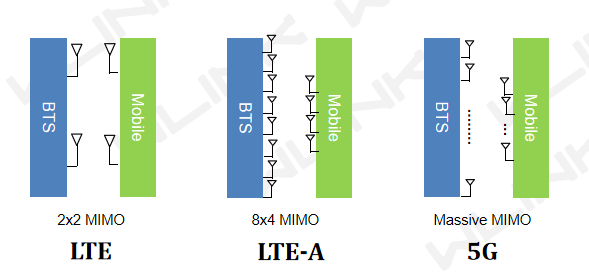
2.5 Small Cells
Small cells are key to the functionality of 5G networks because they provide the increased data capacity that 5G demands. They help the providers reduce costs by eliminating expensive rooftop systems and installation costs. Users can expect improved performance and battery life of mobile handsets since less power is required to transmit data to something nearby.
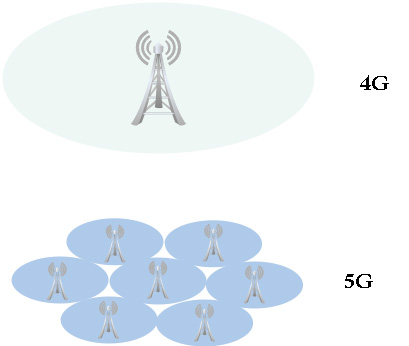
3. Application
Internet of Things is big term often discussed with 5G technology. 5G will connect billions of devices and smart sensors to the internet. 5G network will be capable of handling massive data volume in many applications like smart home, industrial IoT, smart healthcare, smart cities etc..
The hardware of Wlink WL-G510/G500 series are compatible with 5G cellular modules.
- The end











